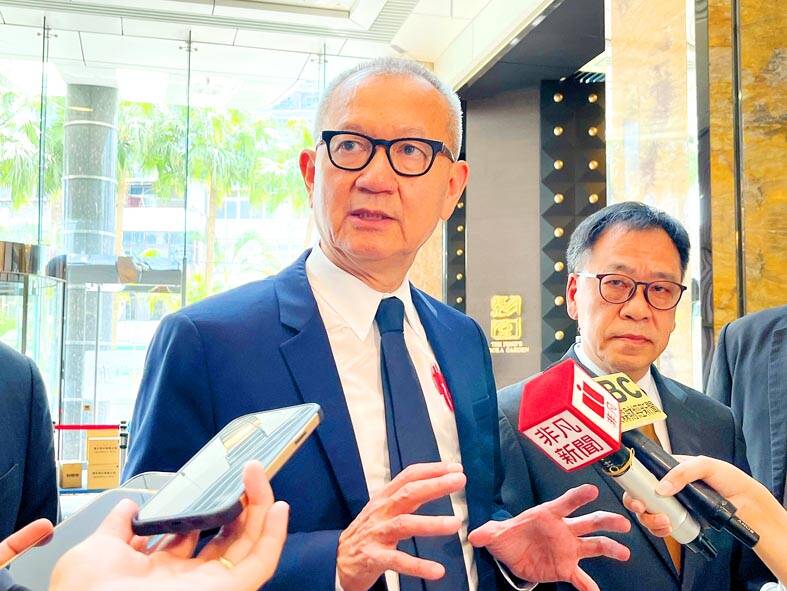Yageo Corp (國巨), the world’s third-largest multilayer ceramic capacitors supplier, saw its stock price spike 1.35 percent in the morning session after it reported a yearly growth of 11 percent in net profits and gave an upbeat outlook for the current quarter.
Shares retreated in the later trading session and closed 0.84 percent lower at NT$588 yesterday. The stock outperformed the broader TAIEX, which tumbled 3.81 percent.
Net profits expanded to NT$4.61 billion (US$141.79 million) last quarter, from NT$4.13 billion in the first quarter last year, representing a quarterly decline of 2.9 percent. Earnings per share rose to NT$11.02 last quarter from NT$9.9 a year earlier, but lower than NT$11.35 a quarter earlier.

Photo: CNA
Yageo is optimistic about this quarter’s business outlook, although full-blown recovery in demand is not happening yet, it said.
One more encouraging sign is that channel inventory correction, which has been closely monitored by investors, is coming to an end this quarter, the company said during an online investors’ conference on Thursday, adding that it already saw “some restocking activities” this quarter.
“From the market side, we see a couple of positive signs. Segments like computing and telecom and mobile are picking up slightly and gradually picking up,” Yageo CEO David Wang (王淡如) said. “We see artificial intelligence [AI] indeed is a very positive trend. We believe that with comprehensive product offerings and strong design capabilities, we are prepared to grow with this trend.”
Yageo has witnessed a significant annual growth in components used in AI applications, such as servers and data centers, in the first quarter of this year, Yageo executive vice president of global sales and marketing Claudio Lollini said on Thursday.
Those components deliver better margins than the corporate average level, given the higher degrees of design involved, Lollini said.
New projects are also kicking in, Lollini added.
For the current quarter, the company saw its book-to-bill ratio stand at 1, Wang said, an indication that the company’s business is in a good shape.
Revenue this quarter is to grow sequentially at a low-single-digit percentage from the NT$28.51 billion generated in the first quarter, Wang said, adding that gross margin would also improve by low-single-digit percentage points from 33.8 percent last quarter.
Yageo also guided for a mild improvement in factory utilization this quarter, likely the first advancement since the fourth quarter of 2022.
The utilization of manufacturing equipment for premier passive components would rise slightly this quarter, compared with 70 percent registered last quarter, Yageo said, adding that the usage of manufacturing equipment for commodity-type products would also go up slightly from 50 percent last quarter.
Premium components accounted for about 75 percent of the company’s revenue, Yageo said.
Its sensor business accounted for 12 percent of the company’s revenue last quarter, which was singled out for the first time since its acquisition of Telemecanique Sensors last year. Magnetic components were the biggest revenue contributor last quarter, accounting for 30 percent. That was followed by multilayer ceramic capacitors’ 20 percent.
The industrial segment made up 36 percent of last quarter’s revenue while the computing, enterprise systems segment, which includes components used in servers, was the second-largest, accounting for 21 percent.

Taiwan’s long-term economic competitiveness will hinge not only on national champions like Taiwan Semiconductor Manufacturing Co. (TSMC, 台積電) but also on the widespread adoption of artificial intelligence (AI) and other emerging technologies, a US-based scholar has said. At a lecture in Taipei on Tuesday, Jeffrey Ding, assistant professor of political science at the George Washington University and author of "Technology and the Rise of Great Powers," argued that historical experience shows that general-purpose technologies (GPTs) — such as electricity, computers and now AI — shape long-term economic advantages through their diffusion across the broader economy. "What really matters is not who pioneers

In a high-security Shenzhen laboratory, Chinese scientists have built what Washington has spent years trying to prevent: a prototype of a machine capable of producing the cutting-edge semiconductor chips that power artificial intelligence (AI), smartphones and weapons central to Western military dominance, Reuters has learned. Completed early this year and undergoing testing, the prototype fills nearly an entire factory floor. It was built by a team of former engineers from Dutch semiconductor giant ASML who reverse-engineered the company’s extreme ultraviolet lithography (EUV) machines, according to two people with knowledge of the project. EUV machines sit at the heart of a technological Cold

TAIWAN VALUE CHAIN: Foxtron is to fully own Luxgen following the transaction and it plans to launch a new electric model, the Foxtron Bria, in Taiwan next year Yulon Motor Co (裕隆汽車) yesterday said that its board of directors approved the disposal of its electric vehicle (EV) unit, Luxgen Motor Co (納智捷汽車), to Foxtron Vehicle Technologies Co (鴻華先進) for NT$787.6 million (US$24.98 million). Foxtron, a half-half joint venture between Yulon affiliate Hua-Chuang Automobile Information Technical Center Co (華創車電) and Hon Hai Precision Industry Co (鴻海精密), expects to wrap up the deal in the first quarter of next year. Foxtron would fully own Luxgen following the transaction, including five car distributing companies, outlets and all employees. The deal is subject to the approval of the Fair Trade Commission, Foxtron said. “Foxtron will be

INFLATION CONSIDERATION: The BOJ governor said that it would ‘keep making appropriate decisions’ and would adjust depending on the economy and prices The Bank of Japan (BOJ) yesterday raised its benchmark interest rate to the highest in 30 years and said more increases are in the pipeline if conditions allow, in a sign of growing conviction that it can attain the stable inflation target it has pursued for more than a decade. Bank of Japan Governor Kazuo Ueda’s policy board increased the rate by 0.2 percentage points to 0.75 percent, in a unanimous decision, the bank said in a statement. The central bank cited the rising likelihood of its economic outlook being realized. The rate change was expected by all 50 economists surveyed by Bloomberg. The